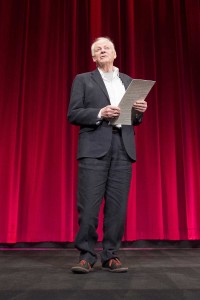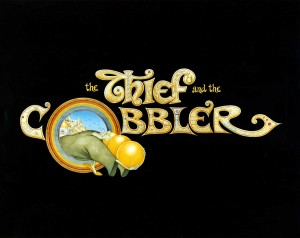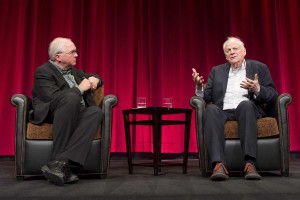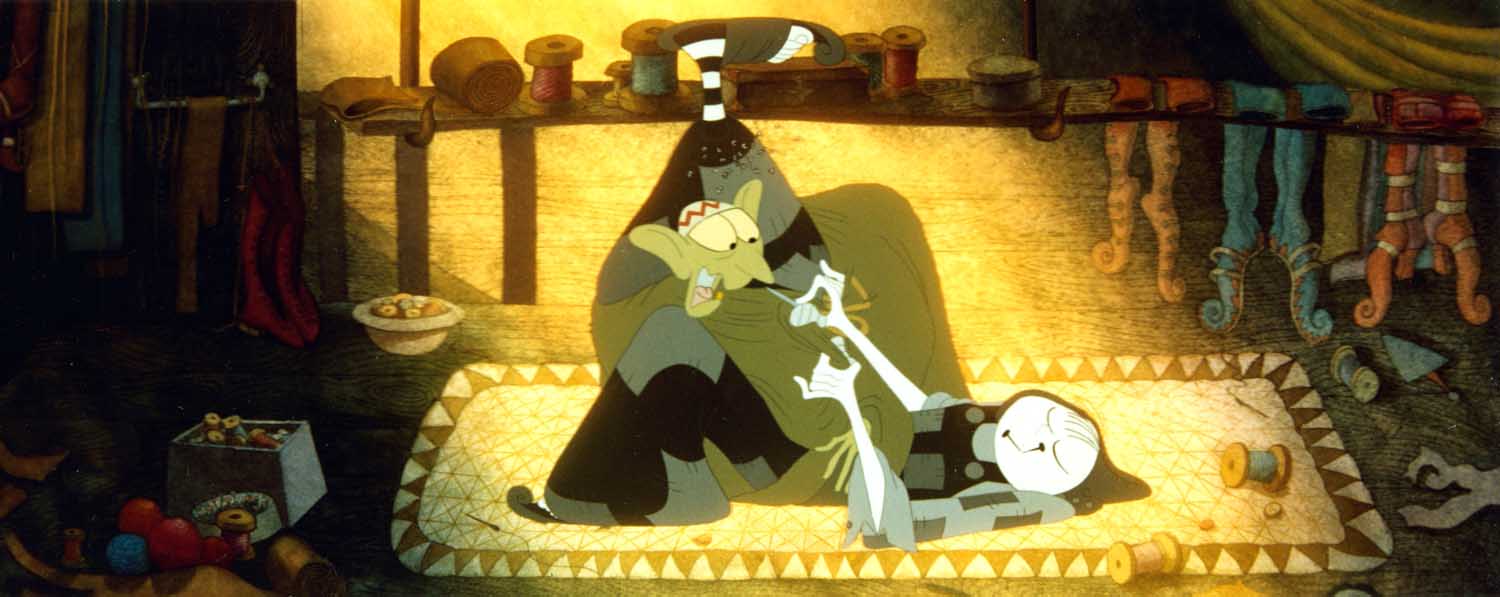![]()

Williams began the Middle Eastern-oriented film in 1968, doing the work in his London studio in small pieces, scattershot between paid jobs. “I did it 20 years before we got full production,” he recalled. “I finessed it myself out of commercials. It was 40 years ago.”
Fortunes changed when Williams, who was directing, acquired a key team member from America. “We had the top Warner Bros. animator, Ken Harris, retired from working with Chuck Jones,” Williams explained. “Chuck was a friend of mine; he helped me in many ways. I was a fan of Ken Harris. Chuck said to write him a fan letter. He came to London and we hit it off. Ken sat down and worked with me.”
By that time, Harris was already 69 years old, but his addition to the Cobbler crew was a shot in the arm to the fledging production. “Because he had done the Roadrunner and Coyote and all the great Warner characters, I thought, ‘I wonder if we could get a pantomime character for him to work with?’” Williams remembered.
For that key villainous character, later known as ZigZag, Williams based him on an actual person. “In Morocco, I met a terrible looking guy who had bought a young wife with a donkey,” Williams said. “I started drawing this character for Ken that I had seen. He grabbed a hold of it and we started working on these short sequences of this pantomime character. I was already messing with the Arabian Knights, and it sort of grew. Ken immediately took to it. He animated most of the piece for the film.”
In the late 1960s and early 1970s, with Williams having sole autonomy as director and a crew of 50 in his studio, the project slowly took form and steadily grew around his passions for the film. “We didn’t know where we were going,” Williams reflected. “The less we knew where we were going, the better the stuff started looking.”
Notably, during that time, the same creative team produced an Oscar-winning short animated version of A Christmas Carol, released in 1972. Then, continuing the similar pattern of taking paid commercial work to fund interstitial Cobbler work, production moved forward through the 1970s but hit a major stumbling block in 1982 when Harris fell ill and died. “An awful lot of work on Thief had been done in rough – one-third by the time Ken died,” Williams noted. “We tried to keep the old guys on the film. We needed to earn our living with the younger guys.”
 Joining the Cobbler crew was another American, Art Babbitt, who, like Harris, had been a pioneering animator. Previously, Babbitt had animated Goofy, the Queen in Snow White, the Mushroom dance in Fantasia and Geppetto in Pinocchio. “He did King Nod through the picture,” Williams related of another key character. “I had worked with him on the picture 18 years.”
Joining the Cobbler crew was another American, Art Babbitt, who, like Harris, had been a pioneering animator. Previously, Babbitt had animated Goofy, the Queen in Snow White, the Mushroom dance in Fantasia and Geppetto in Pinocchio. “He did King Nod through the picture,” Williams related of another key character. “I had worked with him on the picture 18 years.”
An additional Cobbler animator in his 90s at the time, Grim Natwick, yet another American, had designed Betty Boop and animated half of the princess in Snow White. “He worked on the witch in the film for half a year,” remarked Williams. “I was so privileged. I said to Ken after about 12 years, ‘I’ve been drinking your blood all of this time.’ He snickered and put his head in my shoulders.”
With an accumulation of unprecedented animated footage, just after he finished traditional animation on Who Framed Roger Rabbit?, Williams was able to impress production companies and secured completion financing for Cobbler, finally ramping up in 1989. “We went full-time on it when the big money came in and were on it two years,” he said.
Then, though Williams was reticent to relive his personal nightmare in great detail, a series of business decisions ultimately led to Williams losing control of the film. “It was like a terrible accident – many factors, all at once, unexpected,” he stated. “It just happened. That was it. In my wildest dreams, I never would have expected it, and moved on to other things.”
With an outside controlling interest in Cobbler, much of Williams’ work to that point on the film was changed, edited, or wholly discarded, and a butchered version with an alternate title and new voiceovers was hastily released in 1995. “My son was a very good animator and worked a lot of his life on this picture, and said, ‘if you want to jump off a bridge, go see it,’” Williams commented.

To coordinate the screening, Williams’ wife, the co-producer, created a copy of the film from its original elements. “She made an overnight dirty dupe of the working print, and that’s what we have,” Williams said. “This is a moment in time: the whole picture as if you were in our studio that morning that we’d be running to see where we were. It’s got original music and temp music. It’s like going to the opera and seeing half of the people in costume and half of the people in work clothes. I’m very pleased with it. It was the most exciting animation I had ever worked on.”
Noteworthy is the fact that Cobbler, as it was screened, might be the last of its kind – an entirely hand-animated movie by the old guard animators who had worked on the 20th century’s true classics. “What we’ll be showing is the process of making something which is entirely hand-made, color painted by hand,” Williams explained. “There wasn’t a computer shot in it or Xerox. All hand-done. It is the last one ever done that way. You can see the impact it would have made had it been finished.”
For Williams, the idea of a public screening of his intended version of Cobbler had a special meaning. “It’s a tremendously emotional experience for me,” he said. “I don’t have words for it. I start to shake a little bit when I start seeing it. Exciting doesn’t cover it. Pixar wants to see it, and there’s a lot of talk about it.”
Since Miramax owned the latest rights of the officially released version of the film in 1995, they granted the Academy the permission to hold the screening. Beyond that, the future of Williams’ version of the film remains unclear. “It’s safe in the vaults of the Academy in its form as far as it got – the safe rough picture,” said the director. “It’s not like other things in animation. There’s never been anything quite like it.”






